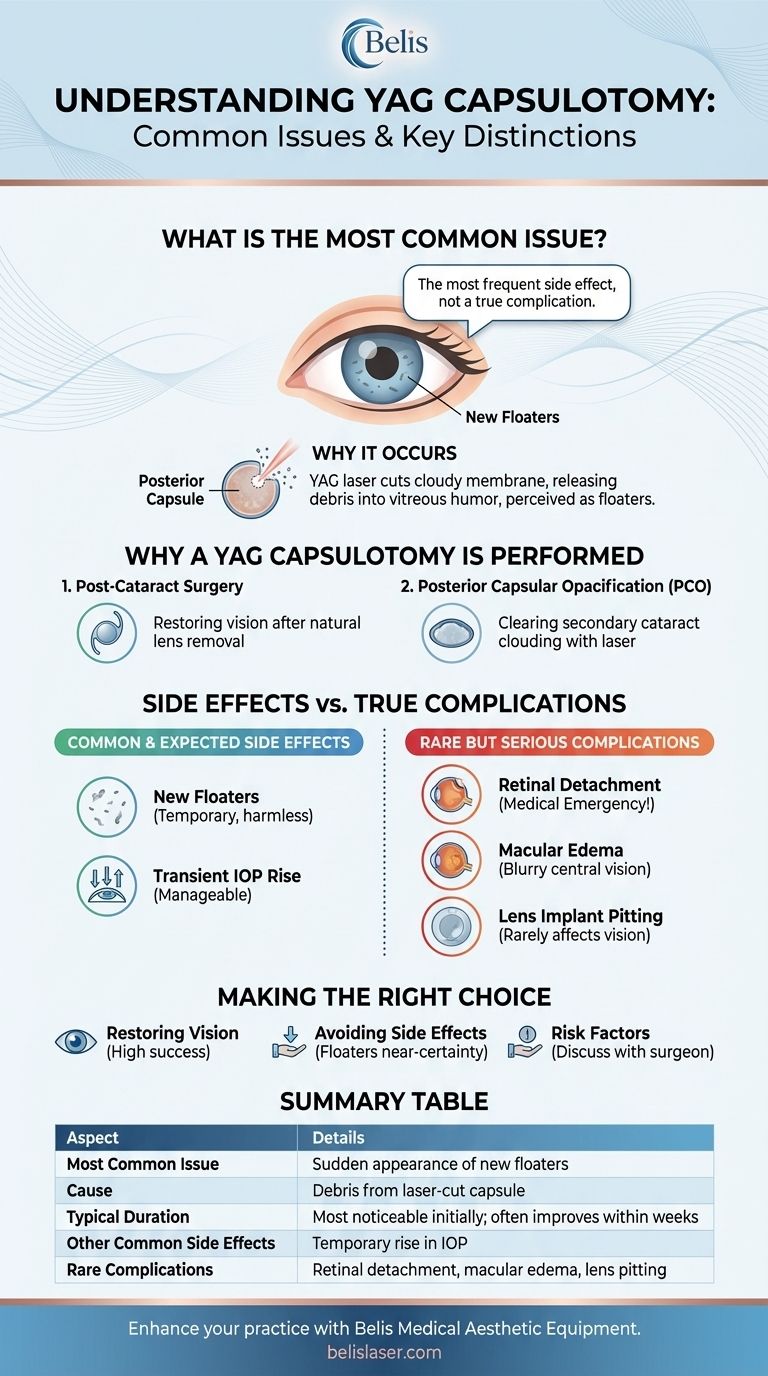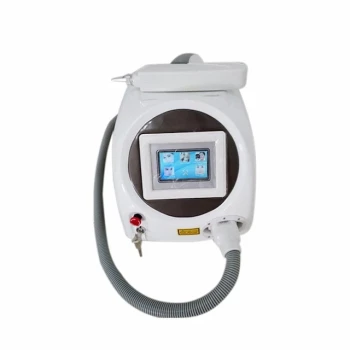The most common issue reported after a YAG laser capsulotomy is a sudden increase in eye floaters. These new floaters are a direct and expected result of the procedure itself, where a laser is used to create an opening in a clouded membrane behind your lens implant. While generally temporary and harmless, they are the most frequent side effect patients experience.
While patients often perceive them as a complication, the appearance of new floaters is an anticipated side effect of a YAG capsulotomy. Understanding why they occur is key to differentiating this common annoyance from the much rarer, true medical complications.

Why a YAG Capsulotomy is Performed
Restoring Vision After Cataract Surgery
A YAG capsulotomy is not a primary surgery, but rather a follow-up procedure for patients who have previously had cataract surgery.
During cataract surgery, the natural lens is removed, but the thin, clear membrane it sat in (the posterior capsule) is left behind to hold the new artificial lens implant.
The Problem of "Secondary Cataracts"
In a significant number of patients, this posterior capsule can become hazy or wrinkled over months or years, a condition called Posterior Capsular Opacification (PCO).
This clouding mimics the symptoms of the original cataract, causing blurry, hazy, or glary vision. The YAG laser is used to create a small, clear opening in this cloudy capsule, allowing light to pass through unobstructed once again.
Understanding Post-YAG Floaters
Where Do They Come From?
The YAG laser does not vaporize the cloudy capsule; it cuts a small hole in it. The tiny fragments of the capsule that are broken loose are then released into the vitreous humor, the gel-like substance that fills the inside of your eye.
These small, free-floating pieces of debris cast shadows on your retina, which you perceive as floaters. They often appear as specks, dots, or cobweb-like strands drifting in your field of vision.
What to Expect
For most people, these new floaters are most noticeable in the first few days or weeks after the procedure.
Over time, two things happen: the debris may settle to the bottom of the eye, moving out of your line of sight, and your brain begins to adapt and "tune out" their presence. While initially disorienting, they typically become much less bothersome within several weeks.
Distinguishing Side Effects from True Complications
It is critical to understand the difference between a common, expected side effect like floaters and a rare but serious complication that requires immediate medical attention.
Common and Expected Side Effects
- New Floaters: As discussed, this is the most common experience.
- Transient Rise in Eye Pressure: It is common for intraocular pressure (IOP) to spike temporarily after the procedure. Your ophthalmologist will typically check your pressure shortly after the laser treatment and may prescribe drops to manage it.
Rare but Serious Complications
- Retinal Detachment: Any procedure that enters the eye carries a very small but serious risk of causing a retinal tear or detachment. Symptoms include a sudden, dramatic shower of floaters, flashes of light, or a curtain-like shadow descending over your vision. This is a medical emergency.
- Macular Edema: In rare cases, swelling can occur in the macula, the central part of the retina responsible for sharp, detailed vision. This can cause blurry or distorted central vision.
- Pitting of the Lens Implant: The laser can inadvertently hit the artificial lens, creating a small pit. This is usually not in the central visual axis and rarely affects vision.
Making the Right Choice for Your Goal
Before proceeding, it's essential to weigh the high success rate of the procedure against its known side effects and risks.
- If your primary focus is restoring clear vision: A YAG capsulotomy is an exceptionally effective and low-risk procedure for correcting the blurriness caused by PCO.
- If your primary focus is avoiding side effects: Understand that a temporary increase in floaters is a near-certainty, but it is a manageable trade-off for clear vision.
- If you have pre-existing risk factors (like high myopia or a history of retinal tears): Have a detailed discussion with your surgeon about the slightly increased, though still very low, risk of retinal detachment.
Ultimately, this procedure is designed to solve a clear problem, and knowing what to expect is the best way to prepare for a successful outcome.
Summary Table:
| Aspect | Details |
|---|---|
| Most Common Issue | Sudden appearance of new floaters |
| Cause | Debris from the laser-cut capsule floating in the vitreous humor |
| Typical Duration | Most noticeable initially; often improves within weeks |
| Other Common Side Effects | Temporary rise in intraocular pressure (IOP) |
| Rare Complications | Retinal detachment, macular edema, lens implant pitting |
Ready to invest in the technology that powers precise procedures like YAG capsulotomies? BELIS specializes in professional medical aesthetic equipment, delivering the reliability and precision required by medical aesthetics clinics and premium beauty salons. Enhance your practice's capabilities and patient outcomes with our trusted technology. Contact our experts today to discover the right equipment for your clinic.
Visual Guide

Related Products
- Q Switch Nd Yag Laser Machine Tattoo Removal Nd Yag Machine
- Clinic Use IPL and SHR Hair Removal Machine with Nd Yag Laser Tattoo Removal
- 12D HIFU Machine Device for Facial HIFU Treatment
- 7D 12D 4D HIFU Machine Device
- Diode Laser SHR Trilaser Hair Removal Machine for Clinic Use
People Also Ask
- What is the mechanism of action of the YAG laser? Precision Cutting & Deep Tissue Coagulation
- What are Q-switched lasers commonly used for? Remove Tattoos & Pigment with Precision
- How does the Nd:YAG laser work? Unlocking Deep-Tissue Precision for Medical Aesthetics
- What are the disadvantages of Q switching? Trade-offs in Pulse Control, Cost, and Beam Quality
- Is Q Switched Nd:YAG laser good? The Gold Standard for Tattoo & Pigment Removal



















